Yao-Yi Chiang
Transit for All: Mapping Equitable Bike2Subway Connection using Region Representation Learning
Jun 18, 2025



Abstract:Ensuring equitable public transit access remains challenging, particularly in densely populated cities like New York City (NYC), where low-income and minority communities often face limited transit accessibility. Bike-sharing systems (BSS) can bridge these equity gaps by providing affordable first- and last-mile connections. However, strategically expanding BSS into underserved neighborhoods is difficult due to uncertain bike-sharing demand at newly planned ("cold-start") station locations and limitations in traditional accessibility metrics that may overlook realistic bike usage potential. We introduce Transit for All (TFA), a spatial computing framework designed to guide the equitable expansion of BSS through three components: (1) spatially-informed bike-sharing demand prediction at cold-start stations using region representation learning that integrates multimodal geospatial data, (2) comprehensive transit accessibility assessment leveraging our novel weighted Public Transport Accessibility Level (wPTAL) by combining predicted bike-sharing demand with conventional transit accessibility metrics, and (3) strategic recommendations for new bike station placements that consider potential ridership and equity enhancement. Using NYC as a case study, we identify transit accessibility gaps that disproportionately impact low-income and minority communities in historically underserved neighborhoods. Our results show that strategically placing new stations guided by wPTAL notably reduces disparities in transit access related to economic and demographic factors. From our study, we demonstrate that TFA provides practical guidance for urban planners to promote equitable transit and enhance the quality of life in underserved urban communities.
StreetLens: Enabling Human-Centered AI Agents for Neighborhood Assessment from Street View Imagery
Jun 17, 2025Abstract:Traditionally, neighborhood studies have employed interviews, surveys, and manual image annotation guided by detailed protocols to identify environmental characteristics, including physical disorder, decay, street safety, and sociocultural symbols, and to examine their impact on developmental and health outcomes. While these methods yield rich insights, they are time-consuming and require intensive expert intervention. Recent technological advances, including vision-language models (VLMs), have begun to automate parts of this process; however, existing efforts are often ad hoc and lack adaptability across research designs and geographic contexts. In this demo paper, we present StreetLens, a human-centered, researcher-configurable workflow that embeds relevant social science expertise in a VLM for scalable neighborhood environmental assessments. StreetLens mimics the process of trained human coders by grounding the analysis in questions derived from established interview protocols, retrieving relevant street view imagery (SVI), and generating a wide spectrum of semantic annotations from objective features (e.g., the number of cars) to subjective perceptions (e.g., the sense of disorder in an image). By enabling researchers to define the VLM's role through domain-informed prompting, StreetLens places domain knowledge at the core of the analysis process. It also supports the integration of prior survey data to enhance robustness and expand the range of characteristics assessed across diverse settings. We provide a Google Colab notebook to make StreetLens accessible and extensible for researchers working with public or custom SVI datasets. StreetLens represents a shift toward flexible, agentic AI systems that work closely with researchers to accelerate and scale neighborhood studies.
Hyper-Local Deformable Transformers for Text Spotting on Historical Maps
Jun 17, 2025Abstract:Text on historical maps contains valuable information providing georeferenced historical, political, and cultural contexts. However, text extraction from historical maps is challenging due to the lack of (1) effective methods and (2) training data. Previous approaches use ad-hoc steps tailored to only specific map styles. Recent machine learning-based text spotters (e.g., for scene images) have the potential to solve these challenges because of their flexibility in supporting various types of text instances. However, these methods remain challenges in extracting precise image features for predicting every sub-component (boundary points and characters) in a text instance. This is critical because map text can be lengthy and highly rotated with complex backgrounds, posing difficulties in detecting relevant image features from a rough text region. This paper proposes PALETTE, an end-to-end text spotter for scanned historical maps of a wide variety. PALETTE introduces a novel hyper-local sampling module to explicitly learn localized image features around the target boundary points and characters of a text instance for detection and recognition. PALETTE also enables hyper-local positional embeddings to learn spatial interactions between boundary points and characters within and across text instances. In addition, this paper presents a novel approach to automatically generate synthetic map images, SynthMap+, for training text spotters for historical maps. The experiment shows that PALETTE with SynthMap+ outperforms SOTA text spotters on two new benchmark datasets of historical maps, particularly for long and angled text. We have deployed PALETTE with SynthMap+ to process over 60,000 maps in the David Rumsey Historical Map collection and generated over 100 million text labels to support map searching. The project is released at https://github.com/kartta-foundation/mapkurator-palette-doc.
MapQA: Open-domain Geospatial Question Answering on Map Data
Mar 10, 2025Abstract:Geospatial question answering (QA) is a fundamental task in navigation and point of interest (POI) searches. While existing geospatial QA datasets exist, they are limited in both scale and diversity, often relying solely on textual descriptions of geo-entities without considering their geometries. A major challenge in scaling geospatial QA datasets for reasoning lies in the complexity of geospatial relationships, which require integrating spatial structures, topological dependencies, and multi-hop reasoning capabilities that most text-based QA datasets lack. To address these limitations, we introduce MapQA, a novel dataset that not only provides question-answer pairs but also includes the geometries of geo-entities referenced in the questions. MapQA is constructed using SQL query templates to extract question-answer pairs from OpenStreetMap (OSM) for two study regions: Southern California and Illinois. It consists of 3,154 QA pairs spanning nine question types that require geospatial reasoning, such as neighborhood inference and geo-entity type identification. Compared to existing datasets, MapQA expands both the number and diversity of geospatial question types. We explore two approaches to tackle this challenge: (1) a retrieval-based language model that ranks candidate geo-entities by embedding similarity, and (2) a large language model (LLM) that generates SQL queries from natural language questions and geo-entity attributes, which are then executed against an OSM database. Our findings indicate that retrieval-based methods effectively capture concepts like closeness and direction but struggle with questions that require explicit computations (e.g., distance calculations). LLMs (e.g., GPT and Gemini) excel at generating SQL queries for one-hop reasoning but face challenges with multi-hop reasoning, highlighting a key bottleneck in advancing geospatial QA systems.
MiTREE: Multi-input Transformer Ecoregion Encoder for Species Distribution Modelling
Dec 25, 2024Abstract:Climate change poses an extreme threat to biodiversity, making it imperative to efficiently model the geographical range of different species. The availability of large-scale remote sensing images and environmental data has facilitated the use of machine learning in Species Distribution Models (SDMs), which aim to predict the presence of a species at any given location. Traditional SDMs, reliant on expert observation, are labor-intensive, but advancements in remote sensing and citizen science data have facilitated machine learning approaches to SDM development. However, these models often struggle with leveraging spatial relationships between different inputs -- for instance, learning how climate data should inform the data present in satellite imagery -- without upsampling or distorting the original inputs. Additionally, location information and ecological characteristics at a location play a crucial role in predicting species distribution models, but these aspects have not yet been incorporated into state-of-the-art approaches. In this work, we introduce MiTREE: a multi-input Vision-Transformer-based model with an ecoregion encoder. MiTREE computes spatial cross-modal relationships without upsampling as well as integrates location and ecological context. We evaluate our model on the SatBird Summer and Winter datasets, the goal of which is to predict bird species encounter rates, and we find that our approach improves upon state-of-the-art baselines.
Context-Aware Trajectory Anomaly Detection
Oct 24, 2024

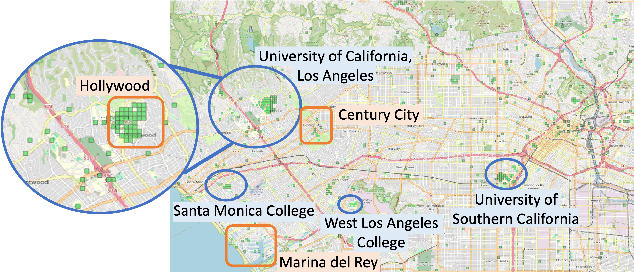

Abstract:Trajectory anomaly detection is crucial for effective decision-making in urban and human mobility management. Existing methods of trajectory anomaly detection generally focus on training a trajectory generative model and evaluating the likelihood of reconstructing a given trajectory. However, previous work often lacks important contextual information on the trajectory, such as the agent's information (e.g., agent ID) or geographic information (e.g., Points of Interest (POI)), which could provide additional information on accurately capturing anomalous behaviors. To fill this gap, we propose a context-aware anomaly detection approach that models contextual information related to trajectories. The proposed method is based on a trajectory reconstruction framework guided by contextual factors such as agent ID and contextual POI embedding. The injection of contextual information aims to improve the performance of anomaly detection. We conducted experiments in two cities and demonstrated that the proposed approach significantly outperformed existing methods by effectively modeling contextual information. Overall, this paper paves a new direction for advancing trajectory anomaly detection.
Automatic Search of Multiword Place Names on Historical Maps
Oct 21, 2024
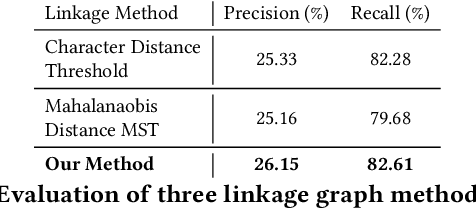
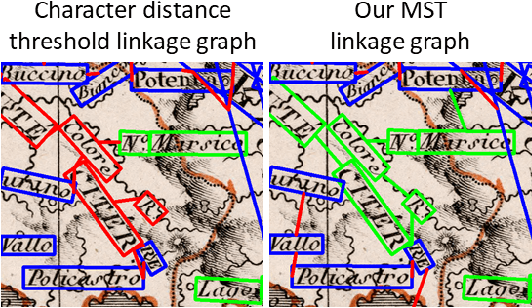

Abstract:Historical maps are invaluable sources of information about the past, and scanned historical maps are increasingly accessible in online libraries. To retrieve maps from these large libraries that contain specific places of interest, previous work has applied computer vision techniques to recognize words on historical maps, enabling searches for maps that contain specific place names. However, searching for multiword place names is challenging due to complex layouts of text labels on historical maps. This paper proposes an efficient query method for searching a given multiword place name on historical maps. Using existing methods to recognize words on historical maps, we link single-word text labels into potential multiword phrases by constructing minimum spanning trees. These trees aim to link pairs of text labels that are spatially close and have similar height, angle, and capitalization. We then query these trees for the given multiword place name. We evaluate the proposed method in two experiments: 1) to evaluate the accuracy of the minimum spanning tree approach at linking multiword place names and 2) to evaluate the number and time range of maps retrieved by the query approach. The resulting maps reveal how places using multiword names have changed on a large number of maps from across history.
Anchors Aweigh! Sail for Optimal Unified Multi-Modal Representations
Oct 02, 2024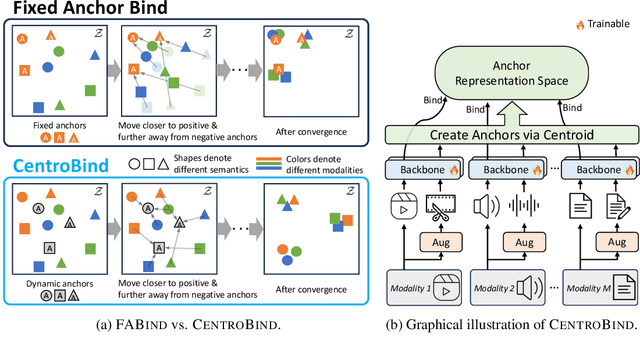
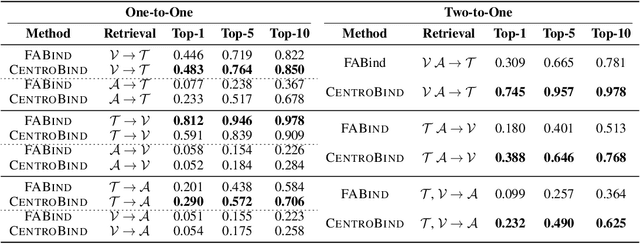
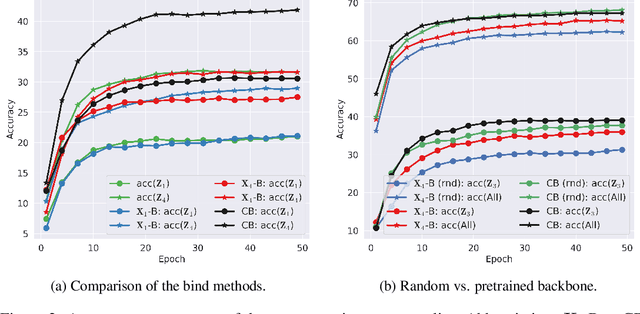
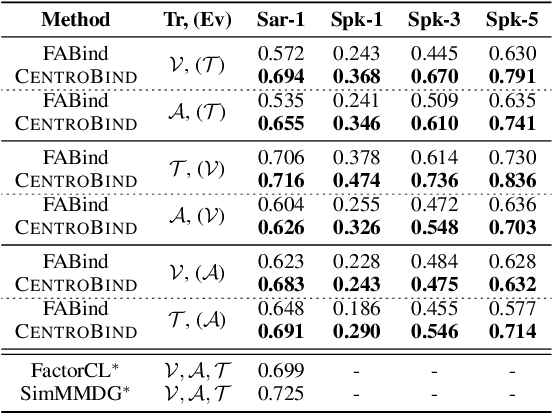
Abstract:Multimodal learning plays a crucial role in enabling machine learning models to fuse and utilize diverse data sources, such as text, images, and audio, to support a variety of downstream tasks. A unified representation across various modalities is particularly important for improving efficiency and performance. Recent binding methods, such as ImageBind (Girdhar et al., 2023), typically use a fixed anchor modality to align multimodal data in the anchor modal embedding space. In this paper, we mathematically analyze the fixed anchor binding methods and uncover notable limitations: (1) over-reliance on the choice of the anchor modality, (2) failure to capture intra-modal information, and (3) failure to account for inter-modal correlation among non-anchored modalities. To address these limitations, we propose CentroBind, a simple yet powerful approach that eliminates the need for a fixed anchor; instead, it employs dynamically adjustable centroid-based anchors generated from all available modalities, resulting in a balanced and rich representation space. We theoretically demonstrate that our method captures three crucial properties of multimodal learning: intra-modal learning, inter-modal learning, and multimodal alignment, while also constructing a robust unified representation across all modalities. Our experiments on both synthetic and real-world datasets demonstrate the superiority of the proposed method, showing that dynamic anchor methods outperform all fixed anchor binding methods as the former captures more nuanced multimodal interactions.
Dynamic GNNs for Precise Seizure Detection and Classification from EEG Data
May 08, 2024Abstract:Diagnosing epilepsy requires accurate seizure detection and classification, but traditional manual EEG signal analysis is resource-intensive. Meanwhile, automated algorithms often overlook EEG's geometric and semantic properties critical for interpreting brain activity. This paper introduces NeuroGNN, a dynamic Graph Neural Network (GNN) framework that captures the dynamic interplay between the EEG electrode locations and the semantics of their corresponding brain regions. The specific brain region where an electrode is placed critically shapes the nature of captured EEG signals. Each brain region governs distinct cognitive functions, emotions, and sensory processing, influencing both the semantic and spatial relationships within the EEG data. Understanding and modeling these intricate brain relationships are essential for accurate and meaningful insights into brain activity. This is precisely where the proposed NeuroGNN framework excels by dynamically constructing a graph that encapsulates these evolving spatial, temporal, semantic, and taxonomic correlations to improve precision in seizure detection and classification. Our extensive experiments with real-world data demonstrate that NeuroGNN significantly outperforms existing state-of-the-art models.
* This preprint has not undergone any post-submission improvements or corrections. The Version of Record of this contribution is published in the proceedings of the 28th Pacific-Asia Conference on Knowledge Discovery and Data Mining (PAKDD 2024), Taipei, Taiwan, May 7-10, 2024, and is available online at https://doi.org/10.1007/978-981-97-2238-9_16
GeoLM: Empowering Language Models for Geospatially Grounded Language Understanding
Oct 23, 2023



Abstract:Humans subconsciously engage in geospatial reasoning when reading articles. We recognize place names and their spatial relations in text and mentally associate them with their physical locations on Earth. Although pretrained language models can mimic this cognitive process using linguistic context, they do not utilize valuable geospatial information in large, widely available geographical databases, e.g., OpenStreetMap. This paper introduces GeoLM, a geospatially grounded language model that enhances the understanding of geo-entities in natural language. GeoLM leverages geo-entity mentions as anchors to connect linguistic information in text corpora with geospatial information extracted from geographical databases. GeoLM connects the two types of context through contrastive learning and masked language modeling. It also incorporates a spatial coordinate embedding mechanism to encode distance and direction relations to capture geospatial context. In the experiment, we demonstrate that GeoLM exhibits promising capabilities in supporting toponym recognition, toponym linking, relation extraction, and geo-entity typing, which bridge the gap between natural language processing and geospatial sciences. The code is publicly available at https://github.com/knowledge-computing/geolm.
 Add to Chrome
Add to Chrome Add to Firefox
Add to Firefox Add to Edge
Add to Edge